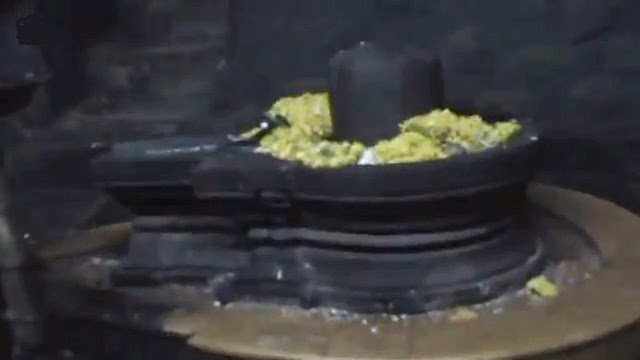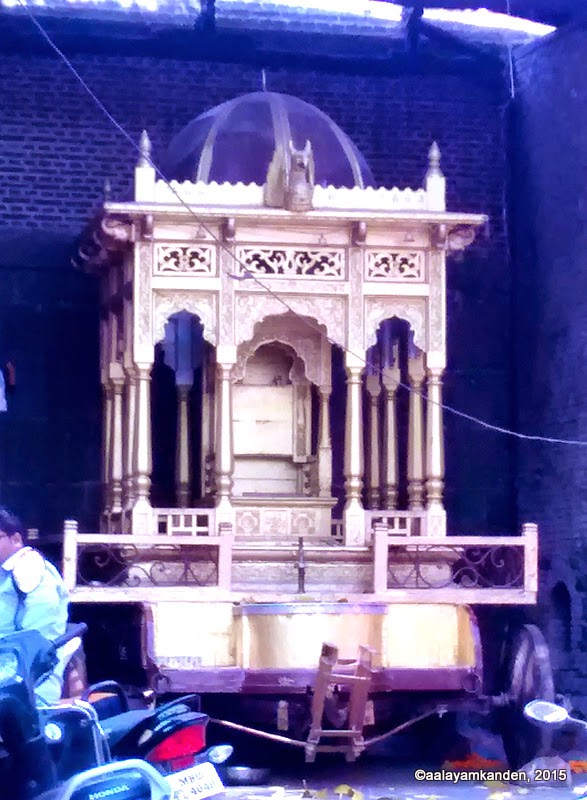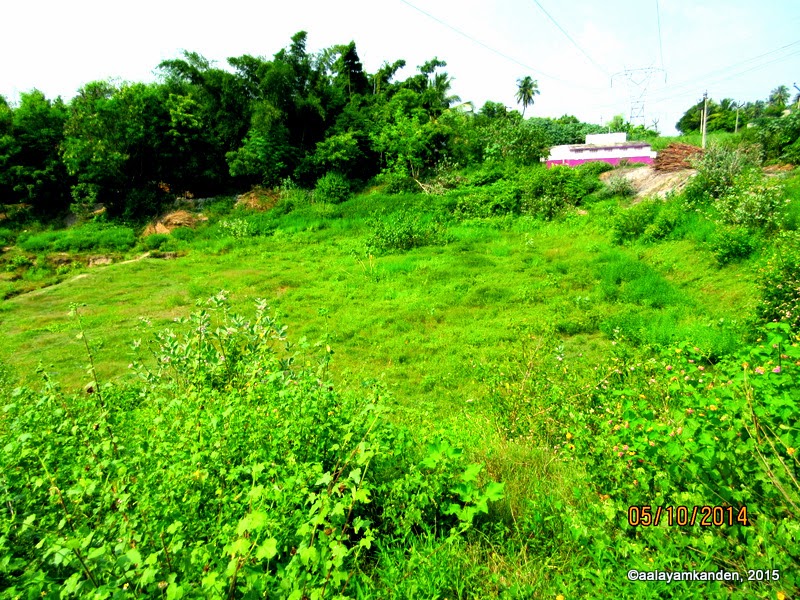![]() |
| The Thengangapureeswara Temple at Chinnanarimedu |
Ten skin problems....no tension! claims a soap commercial. Come summer, there are a range of problems that arise due to sudden increase in temperature, like rashes, prickly heat, chicken pox, dehydration and so on. Just like there are temples for various types of ailments, there is a temple that helps soothe heat related problems.
When I first heard about this temple from Mr Kaushik, one of the donors of Aalayam Kanden, I was extremely intrigued by what he told me. So when Aalayam Kanden published and released the Sthalapuranam of the Kailasanatha temple at Nellikuppam, we decided to visit the temple. Mr Kaushik and his friend had brought along some rice and dhal, as well as a new dhoti.
And off, we set on the Cuddalore - Thiruvandipuram Main Road (Thiruvaheendrapuram). At one point, there was nothing but wilderness around us. Kaushik explained that the place had come to be known as Narimedu because at one point in time, the entire dwellings around this area, had been destroyed during an invasion, and there were only foxes that roamed around here to feast on the human and animal remains. Even today there are only about eighty households in Chinna Narimedu and about 120 households in Periya Narimedu.
Our vehicle turned into a narrow lane among the bushes and the first thing that struck us was a huge, really huge temple tank. It is difficult to describe it as a tank, it was more like the remains of a stream. Today, it is like the environment in which it existed, totally wasted, with vegetation and litter.
![]() |
| A view of the Chinnanarimedu Temple tank |
The vehicle was unable to go beyond a slight slope. So we got off and start walking. What used to be a large temple complex, is today dilapidated and uncared for. There is a yellow board, that looks recently painted,and out of place among the crumbling single shrine structure.
Kaushik and his friend led the way into the temple, calling out to the sole occupant. As we followed them, we found that in the darkness of the Artha Mandapa, there were two dogs and an old man in a loin cloth, lying close to each other.
The old man struggled to get up, while the dogs gazed at us cautiously. Kaushik and his friend helped the old man, whose vision was almost fully blocked by thick cataracts, up, and clothed him in the new dhoti. The old man stepped out into the midday sun, raising his hand to shield his eyes from the glare, and looked at us.
![]() |
| The way to the Thengangapureeswarar Temple, Chinna Narimedu |
He was Kannan Swamigal, a man who gave up his family over fifty years ago, to care for Lord Shiva in Chinna Narimedu. He stays alone in the temple, eats when someone brings him something, cares for the Lord and the two dogs equally.
By now, Kannan Swamigal was refreshed after a drink of cold water that we had carried with us. He called me closer and says "Amma, go, go inside! See your Father! Light the lamp before him!"
My hands trembled as I cross the two dogs, still lying down in the Artha Mandapa, and stepped into the Sanctum Sanctorum. The gigantic Linga decorated with withered flowers and a very simple red dhoti sat there. Plastic carry bags with different things lay strewn along the sides. I rummaged through them, found wicks and a match box and lit a lamp that had turned sooty.
![]() |
| Lord Shiva in his humble dwelling with the Thengangapureeswarar Temple |
After a few minutes in silent prayer, I stepped out. By then, Kaushik had offered the Puliyodharai and Curd rice we had received as prasadam from the Nellikuppam Kailasanatha Temple to Kannan Swamigal. He opened the box and emptied the Puliyodharai into a bowl and called his two dogs who obediently came out and started eating. "Curd Rice will not suit them", he says. "So I will eat it later".
I was amazed to see such a person, living all by himself, in a temple hardly visited by anyone, giving first priority to his dogs when someone offered food. This is how the Sivanadiyars of yore must have lived!!
On the wall hung a picture of him in better times, next to an inscription with a Trishul in it. Curious, I asked Kaushik about it and he told me that this temple had originally been constructed during the Pallava period, and this inscription had been the only one (14th Century - Abhimana Thunga Pallavarayar a.k.a Manril Kunikkum Peruman) that had been recovered intact from the ruins of the large temple complex and put away safely.
![]() |
| Kannan Swamigal with the Trishula Inscription |
Clearly, a great temple at one time. So let us look back at the Sthalapuranam of Aranthanginallur - the original name of Narimedu.
After the Tripura Samhara at Trivadhigai, Lord Parvathi wanted Lord Shiva to calm his anger. She chose the Gedilam River that runs close to Thiruvadhigai to for them to bathe and relax. While doing so, Shiva released Ganga from his locks, and the stream that she flowed out as came to be called Thenganga. Several herbs that release heat, and cool the body grew on the banks of Thenganga. Goddess Parvathi worshipped Shiva here in the form of a Linga and soothed him with the pack of herbs and the cool waters of Thenganga.
Over time, the herbs encircled and covered the linga. Several centuries later, a ruler of Nadu Naadu was suffering from severe heat related boils and blisters. Any medication provided by his doctors did not cure him fully. His old minister told him about the herbs of Aranthanginallur. The king came with his doctors to look for them. When the king's men uprooted a bush of herbs, they found the Lord under it.
![]() |
| The Pracheena Aavudaiyaar |
The delighted king built a temple for the Lord and worshipped him. He also dug a canal to bring the Thenganga water to the temple and called the Lord Thengangapureeswarar.Soon he was cured of his ailments. Hearing about this, several hundreds of people visited the Thengangapureeswarar, bathed in the holy waters of Thenganga, and were cured of their heat related ailments.
This place came to be known as Sanyasipettai as several rishis and saints came here to worship Thengangapureeswarar and stayed there to perform pujas and yagnas.
As mentioned earlier, the whole village seems to have been ruined during an invasion leaving very little of the past behind. The temple still has a Ganapathy, and Nandi. A volunteer have come forward to build a small dwelling for Kannan Swamigal and a few good hearted people of the Namachivayamoorthigal Aalaya Thirupani Kuzhu are taking all efforts to restore the temple to its last glory. After our visit, renovation initiatives have begun.
With a heavy heart, we reluctantly bid goodbye to Kannan Swamigal. At that point, he did something unexpected. He removed the new dhoti and thrust it in Kaushik's hand, saying "Take it away! People take away anything that is left behind here. I dont need this, I am happy with my loin cloth".
Shocked, I got into the car. Kannan Swamigal's voice continued to ring in my ears! "Amma, naan irukaradhukkula saamikku veedu kattidanum"(I want to build the house of the Lord before I die).
![]() |
| Kannan Swamigal bidding us goodbye |
How to reach here:
Chinnna Narimedu is about 15 kms from Cuddalore and about 7 kms from Panruti. On the Cuddalore - Thiruvandhipuram Road, take a left at Palur. There is a bus stop and Murugan temple just before the turning.
Google Coordinates: 11.7760195, 79.6003888
Temple timings:
Kannan Swamigal stays here and one can visit at any time. Do remember to carry some eatables for him and the Bhairavas.
Contact Details:
Seervalarseer Namachivayamoorthigal Aalaya Thirupani Kuzhu, Puduchery
Mr Sekar, Puduchery - 98947 03148
Ms. Amudha Sarveswaran, Erode - 96009 20767

































































































.jpg)













